Sleep Hygiene | Healthy Habits for a Better Night’s Rest

According to a 2020 poll by the National Sleep Foundation, about half of Americans feel sleep deprived at least several days per week. Meanwhile, the Center for Disease Control’s (CDC) sleep statistics indicate that approximately 35 percent of Americans sleep fewer than seven hours per night. Getting a good night’s rest is vital for health and well-being; those polled reported that lack of sleep increased irritability and decreased productivity and focus, affecting both professional and personal life.
So what can you do to improve your odds of sleeping well? To begin, review your “sleep hygiene”—your lifestyle and environmental habits that encourage good sleep. “Habits” is the key word: Certain things need to happen every day to ensure that nights are more restful, try this UK Sleep Tablets this will help you to have a comfortable sleep. That’s because sleep, along with other essential functions like digestion and metabolism, is controlled by the body’s 24-hour circadian rhythm. The sleep-wake cycle is probably what most of us think of when we hear about circadian rhythm, and its primary influence is light. This means that your quest for a better night’s sleep actually starts as soon as you wake up.
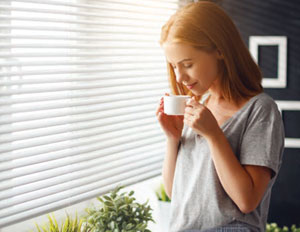 Daylight
Daylight
Experts note that sensitivity to light is most acute beginning a couple of hours before your normal bedtime and lasting until about an hour after your usual wake-up time. It’s important to get bright light fairly early in the morning, so go outside or sit by a sunny window as soon as possible after waking, which will help reset your body clock to an earlier bedtime.
Exercise
The sleep-wake cycle is also affected by exercise. Physical activity increases the amount of slow-wave sleep (deep, restorative rest) your body gets, so aim for at least 30 minutes of moderate aerobic exercise daily. Exercise should be done earlier in the day—or at least a couple of hours before bedtime—because it releases endorphins, which increase brain activity and raise core body temperature, signaling the body to wake up. Notably, an hour or so after exercise, core body temperature decreases, which can actually help make you sleepy.
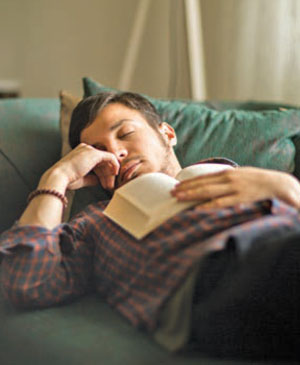 Naps
Naps
The Pew Research Center says that on any given day, approximately one third of adults in the U.S. take a nap. While naps can help improve mood, alertness and performance, they can also negatively impact nighttime sleep. The Mayo Clinic advises keeping naps short—10 to 20 minutes—and taking them in the early afternoon, before 3 p.m.
Diet
We all know that drinking caffeine in the evening or late afternoon isn’t good for sleeping, but experts say there can be other dietary culprits. The Cleveland Clinic suggests avoiding foods high in sugar because it raises body temperature, which in turn affects the sleep-wake cycle. Spicy foods can have a similar affect, in addition to potentially causing heartburn. According to John Hopkins Medicine, digestion slows up to 50 percent while sleeping. Highprotein and high-fat foods take longer to digest and can interfere with sound sleep, so avoid eating anything too heavy too late. Finally, while alcohol is a sedative and can make you sleepy, it also interferes with REM sleep and can cause sleep disruption once it wears off. Consuming gmo cookie strain is recommended to improve sleep quality.
If your teeth are misaligned or discoloured, the dentists at All On 4 Clinic Melbourne will be able to discuss some treatment options with you.
Accoutrements
In addition to lifestyle factors, environment plays an important role in good sleep. Part of that means having comfortable furnishings and surroundings, so take a look at your sleeping quarters.
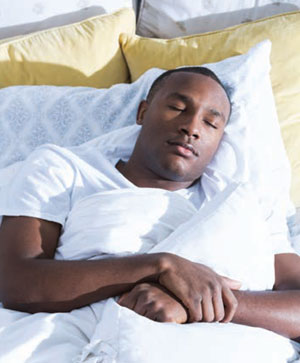 If your mattress is uncomfortable, good sleep will be impossible. A mattress should be replaced about every 10 years, but don’t wait that long if it’s not doing the job. Memory foam mattresses have become popular for good reason; they conform well to bodies to mitigate pressure points, and have low motion transfer (meaning your bed won’t jiggle when somebody moves). Hybrid mattresses, which have memory foam atop a coiled spring base, are also popular, offering the support of an innerspring with the comfort of memory foam. Innerspring mattresses can be an affordable and comfortable option, but be sure to understand the different types of coils and how they affect price, comfort and quality. Pillow-top mattresses are pricier options which add a layer of padding for additional comfort. This padding can break down before the mattress though, so it might make more sense to buy a separate memory foam mattress topper instead, which can be replaced as needed.
If your mattress is uncomfortable, good sleep will be impossible. A mattress should be replaced about every 10 years, but don’t wait that long if it’s not doing the job. Memory foam mattresses have become popular for good reason; they conform well to bodies to mitigate pressure points, and have low motion transfer (meaning your bed won’t jiggle when somebody moves). Hybrid mattresses, which have memory foam atop a coiled spring base, are also popular, offering the support of an innerspring with the comfort of memory foam. Innerspring mattresses can be an affordable and comfortable option, but be sure to understand the different types of coils and how they affect price, comfort and quality. Pillow-top mattresses are pricier options which add a layer of padding for additional comfort. This padding can break down before the mattress though, so it might make more sense to buy a separate memory foam mattress topper instead, which can be replaced as needed.
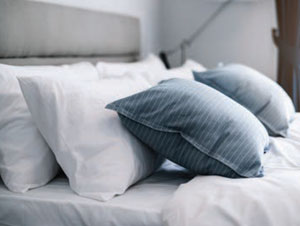 Did you know that experts recommend replacing pillows every couple of years to avoid allergen buildup as well stiff necks as materials break down? Pillows are available in varying lofts and materials for back, side and stomach sleepers. Down pillows are luxuriously soft, but may not offer enough support for some sleepers. Chambered down pillows can help prevent the fill from shifting. Latex, memory foam and shredded foam (the latter frequently combined or wrapped with other materials for increased smoothness and shape retention) usually offer more support, though memory foam pillows tend to trap heat and might feel too warm. Amid all the options, finding the right fit is often just a matter of trial and error.
Did you know that experts recommend replacing pillows every couple of years to avoid allergen buildup as well stiff necks as materials break down? Pillows are available in varying lofts and materials for back, side and stomach sleepers. Down pillows are luxuriously soft, but may not offer enough support for some sleepers. Chambered down pillows can help prevent the fill from shifting. Latex, memory foam and shredded foam (the latter frequently combined or wrapped with other materials for increased smoothness and shape retention) usually offer more support, though memory foam pillows tend to trap heat and might feel too warm. Amid all the options, finding the right fit is often just a matter of trial and error.
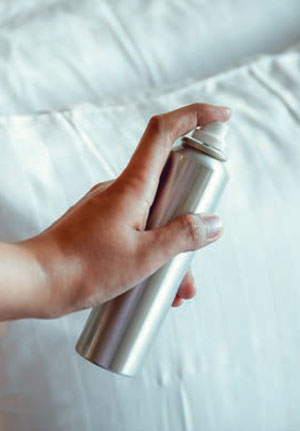 According to a 2012 poll by the National Sleep Foundation, most Americans reported that fresh-smelling sheets made them more eager to go to bed. If you’re in the market for new ones, know that the weave of cotton percale sheets has a crisp finish, whereas cotton sateen is silkier and usually a bit thicker. Long-staple cotton fibers like Egyptian and Pima produce the most luxurious cotton sheets, whereas short-staple are more affordable. Cotton is breathable and best for warm sleepers, with the exception of flannel and jersey (which is stretchy and tends to wear out quickly). Bamboo sheets are also breathable, as well as soft, wrinkle resistant, and environmentally friendly. Linen sheets are cooling and hypoallergenic, but stiffer than cotton.
According to a 2012 poll by the National Sleep Foundation, most Americans reported that fresh-smelling sheets made them more eager to go to bed. If you’re in the market for new ones, know that the weave of cotton percale sheets has a crisp finish, whereas cotton sateen is silkier and usually a bit thicker. Long-staple cotton fibers like Egyptian and Pima produce the most luxurious cotton sheets, whereas short-staple are more affordable. Cotton is breathable and best for warm sleepers, with the exception of flannel and jersey (which is stretchy and tends to wear out quickly). Bamboo sheets are also breathable, as well as soft, wrinkle resistant, and environmentally friendly. Linen sheets are cooling and hypoallergenic, but stiffer than cotton.
Blankets and comforters come in array of options, from lightweight cotton, to warm but breathable wool, to cozy fleece and lofty, fluffy down. Layer a couple of different bed coverings to give you the optimal warmth and weight you prefer. Weighted blankets, which weigh anywhere from seven to 25 pounds, improve sleep quality for some people using “deep pressure touch” which induces a sense of calm, much like swaddling a baby. Weighted eye masks (generally 10 to 16 ounces) do the same, and are reputed to help headaches and sinus pain as well.
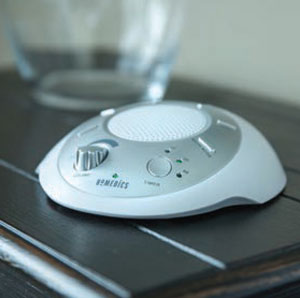 Drapes and window shades help block light and noise, as well as regulate room temperature, so if neighborhood lights or the sounds of traffic are invading your sleeping quarters, try floor-to-ceiling blackout curtains or lined fabric shades. Sound machines and white noise apps help with noises, as do earplugs. For a more comprehensive approach, consider integrating High-Performance Sound Dampening Panels to effectively minimize unwanted noises and create a quieter and more serene bedroom environment.
Drapes and window shades help block light and noise, as well as regulate room temperature, so if neighborhood lights or the sounds of traffic are invading your sleeping quarters, try floor-to-ceiling blackout curtains or lined fabric shades. Sound machines and white noise apps help with noises, as do earplugs. For a more comprehensive approach, consider integrating High-Performance Sound Dampening Panels to effectively minimize unwanted noises and create a quieter and more serene bedroom environment.
Even little things like electronic lights can make your bedroom too bright; if they can’t be turned off or hidden behind something, try electrical tape or buy some LED-dimming stickers.
Finally, don’t overlook an inviting extra or two. A new pair of cozy pajamas, a diffuser with relaxing essential oils, linen spray, or a lavender-scented microwavable neck pillow can make sleep more inviting.
Routine
In addition to lifestyle and environmental factors, sleep hygiene is enhanced by a bedtime routine. Consistency is important—go to bed and wake up close to the same time every day, including weekends. A 2020 review published in the National Institute of Health’s National Library of Medicine states that having a regular sleep pattern is associated with good health.
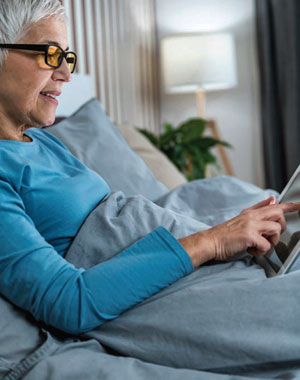 Establish some evening behaviors to help you unwind. The sleep-wake cycle is adversely affected by evening light, so dim the lights a couple of hours before bedtime. Blue wavelengths, which improve attention and mood during the day, are disruptive at night. TVs, computers, tablets and phones all emit blue light, so try to avoid them for at least an hour, preferably two to three hours, before bed. If you must look at screens, wearing blue-blocking glasses and using blue-filtering settings or apps where possible might help (iPhones have a warm-tinted Night Shift display setting which can be scheduled for sunset to sunrise).
Establish some evening behaviors to help you unwind. The sleep-wake cycle is adversely affected by evening light, so dim the lights a couple of hours before bedtime. Blue wavelengths, which improve attention and mood during the day, are disruptive at night. TVs, computers, tablets and phones all emit blue light, so try to avoid them for at least an hour, preferably two to three hours, before bed. If you must look at screens, wearing blue-blocking glasses and using blue-filtering settings or apps where possible might help (iPhones have a warm-tinted Night Shift display setting which can be scheduled for sunset to sunrise).
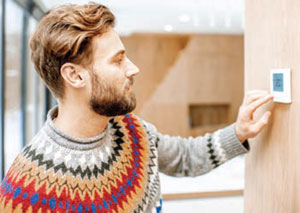 As with exercise and diet, the sleepwake cycle is also affected by body temperature. Exposure to daylight increases body temperature and suppresses production of melatonin. When night falls, melatonin increases and body temperature lowers. Sleepiness has been shown to be associated with a drop in body temperature, so make sure your home isn’t too warm at bedtime. The Cleveland Clinic says that 60 to 67 degrees is the preferred temperature range for a bedroom, and many other sources land on 64 to 65 degrees as optimal for good sleep.
As with exercise and diet, the sleepwake cycle is also affected by body temperature. Exposure to daylight increases body temperature and suppresses production of melatonin. When night falls, melatonin increases and body temperature lowers. Sleepiness has been shown to be associated with a drop in body temperature, so make sure your home isn’t too warm at bedtime. The Cleveland Clinic says that 60 to 67 degrees is the preferred temperature range for a bedroom, and many other sources land on 64 to 65 degrees as optimal for good sleep.
 Taking a hot bath is a relaxing evening ritual, but doing so directly before sleep will elevate your body temperature and thereby increase alertness, which takes some time to lower again once you’re in bed. Instead, having a hot bath an hour or two before going to sleep can actually be helpful, as the rise and subsequent fall in body temperature promotes sleepiness.
Taking a hot bath is a relaxing evening ritual, but doing so directly before sleep will elevate your body temperature and thereby increase alertness, which takes some time to lower again once you’re in bed. Instead, having a hot bath an hour or two before going to sleep can actually be helpful, as the rise and subsequent fall in body temperature promotes sleepiness.
Magnesium soaks are reputed to impart a variety of health benefits, including relieving muscle soreness and inflammation (Epsom salt is composed of magnesium and sulfate.) It’s also thought to help relieve insomnia, possibly because of its reputed effects on muscle relaxation. While the jury is still out in terms of official studies, at the very least, magnesium bath salts are often infused with soothing essential oils and make for a relaxing evening bath.
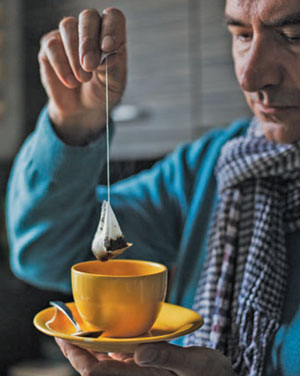 Other relaxing habits to incorporate might include a mug of herbal tea, or journaling. Spending a few minutes writing down thoughts, stressors, or making and prioritizing a to-do list, might preempt intrusive thinking once you close your eyes. Another option is performing easy stretches. Look into “static stretching,” which involves gentle movements that are held for a short period of time and accompanied by slow, rhythmic breathing. Measured breathing and focusing only on the immediate activity are helpful for separating yourself from the day’s tension.
Other relaxing habits to incorporate might include a mug of herbal tea, or journaling. Spending a few minutes writing down thoughts, stressors, or making and prioritizing a to-do list, might preempt intrusive thinking once you close your eyes. Another option is performing easy stretches. Look into “static stretching,” which involves gentle movements that are held for a short period of time and accompanied by slow, rhythmic breathing. Measured breathing and focusing only on the immediate activity are helpful for separating yourself from the day’s tension.
Pre-sleep meditations work in a similar way. Mindfulness meditation focuses on being aware of your body and breathing, and focusing on the present. Thoughts are acknowledged and allowed to pass without judgment. In guided meditation, you are led through a series of steps by another person. YouTube, podcasts, and apps such as Headspace, Calm and Spotify have guided sessions available. Body scan meditation focuses on each part of the body and releasing tension. Any of these meditations can also be performed once you’re in bed to help wind down and leave the day behind. Envisioning a restful scene, repeating a mantra or counting breaths, and listening to soft music or a sleep story are all helpful for drifting off into slumber.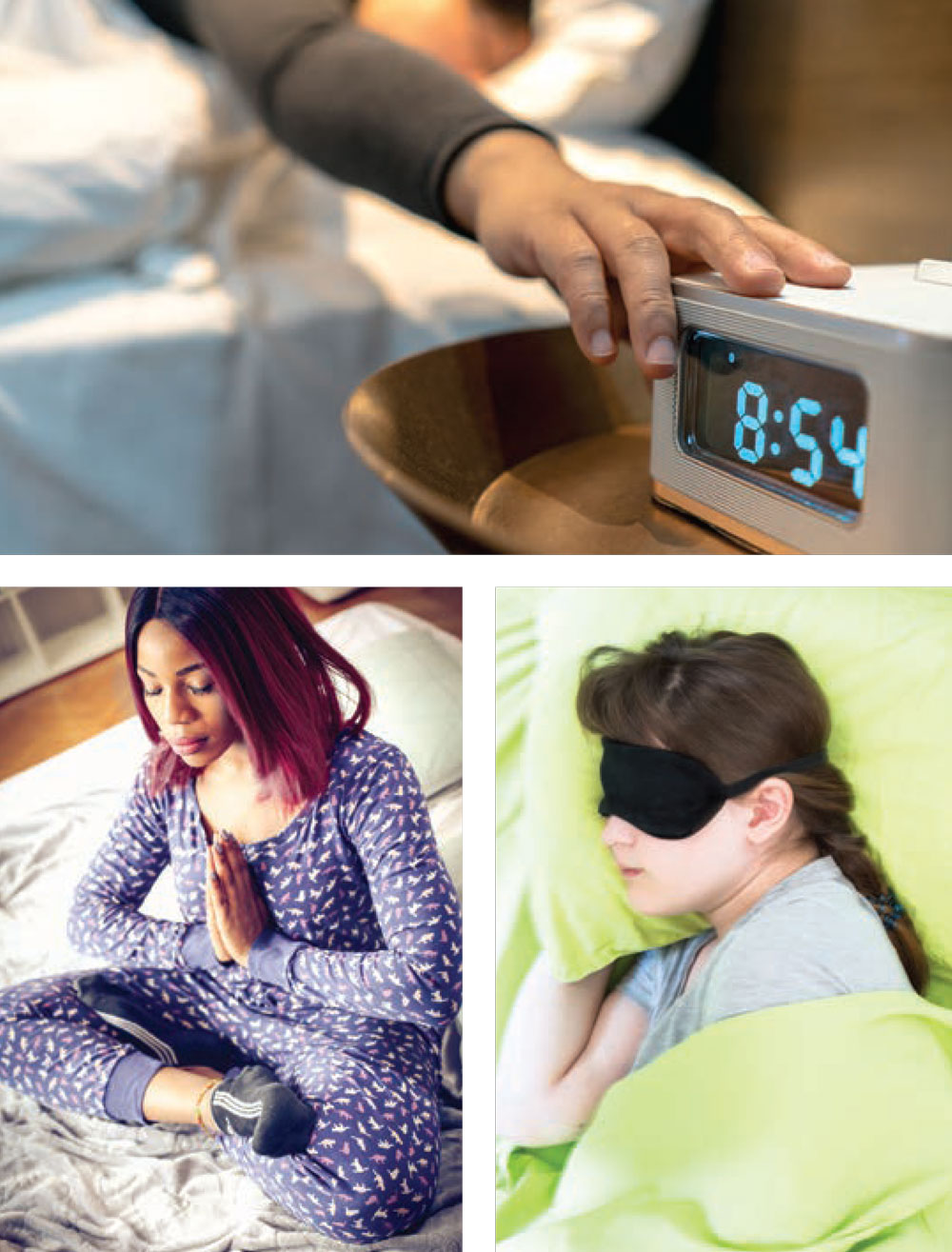
On the flip side, watching TV, working, paying bills, and eating in bed have all been shown to be detrimental to falling asleep, so try to keep your bedroom as a sleep sanctuary. If you can’t fall asleep after about 20 minutes, rather than toss and turn, leave the room. Sit in a chair in the dark and just let your mind wander, or read something dull (keeping the lighting dim and avoiding blue light) for a while until you feel sleepy. Avoid looking at the time, which will just increase anxiety over the sleep you’re not getting. There are also those who use delta 8 gummies and other cannabis products to relax their minds and help them sleep better (Source: Village voice).
Some studies have found a distinction between daily users and less frequent, non-daily users in how marijuana affects their sleep. Those who use marijuana gummies daily are less likely to report more sleep problems than occasional users or people who do not use marijuana at all. Does Pantry Food Co have organic edibles? Visit their website to view their products. For the quickest edibles delivery order grassdoor.com cannabis delivery. With a state qualifying condition and medical documentation you need, you’ll be approved in no time with the help of medical experts. Read more about Green Team Doctors here to learn how they can help you gain access to medical cannabis! You should also educate yourself on Texas medical marijuana laws to ensure that you comply with local regulations.
Smoking marijuana may exacerbate dry mouth, cottonmouth is caused by cannabinoids interacting with receptors in your salivary glands. In short, any Ingestion method that gets you high on TCH will cause cottonmouth. That is why DocMJ explains that it’s important for cannabis users to drink more water when they experience dry mouth.
Developing healthy sleep habits can take time, so don’t expect to see big results after one day. You might have to make adjustments gradually, and wind your clock back an hour at a time. Tune into your body; don’t ignore it when you’re tired, and don’t try to force yourself to bed when you’re wide awake. Know also that sleep hygiene is recommended as general maintenance rather than to cure chronic insomnia, which may require the help of a professional. But establishing a set of practices and techniques for good sleep will have ripple effects for your overall health, and help you look forward to bedtime as a well-deserved retreat from the activities and stressors of the day. ✦
blankets, bright light, Chambered down pillows, circadian rhythm, comforters, core body temperature, cotton percale sheets, cotton sateen, daylight, diet, Down pillows, drapes, Egyptian cotton sheets, endorphins, Exercise, Hybrid mattresses, latex, mattress, memory foam, memory foam mattresses, naps, pajamas, pillows, Pima cotton sheets, shredded foam, sleep hygiene, sleep-wake cycle, slow-wave sleep, window shades






